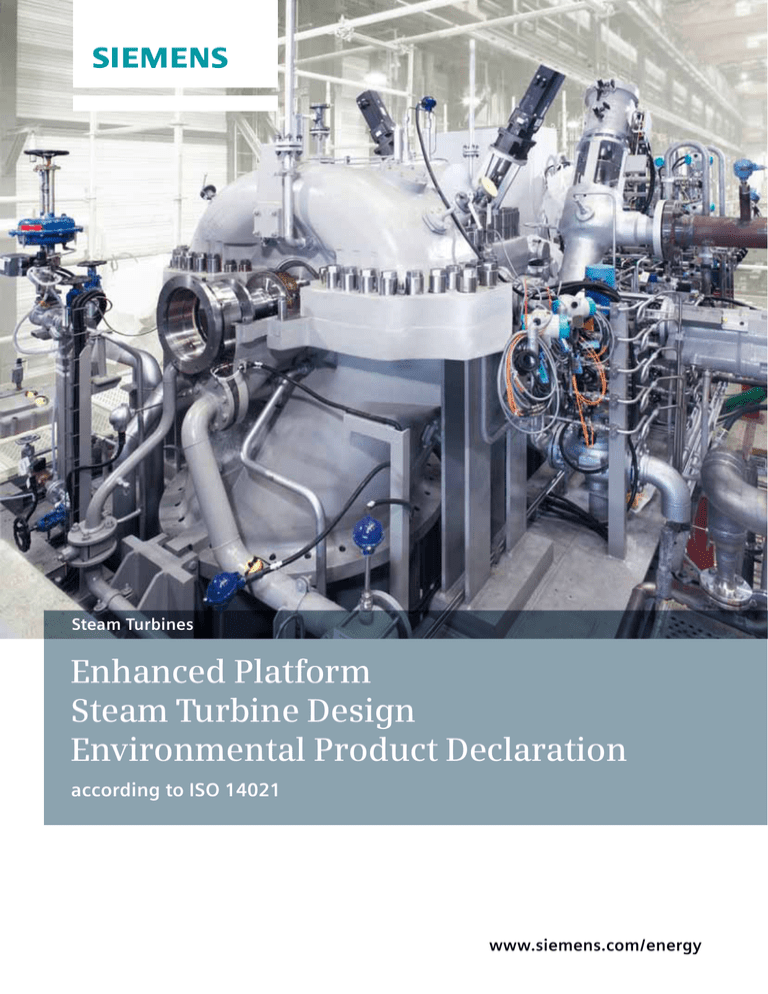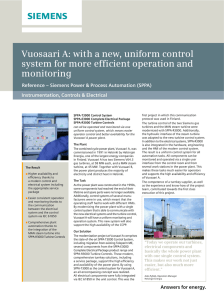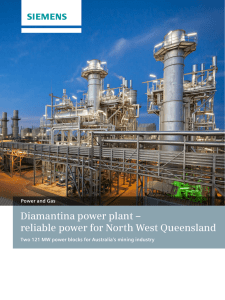
Steam Turbines
Enhanced Platform
Steam Turbine Design
Environmental Product Declaration
according to ISO 14021
www.siemens.com / energy
2
Sustainability as Opportunity
Sustainability is the basis for how we do business
Our goal is to create value for the long term by treating
people and the environment in a responsible manner.
Innovative products and solutions are the foundation
for our success
They help our customers to achieve their business goals
while meeting global challenges such as urbanization,
demographic change, climate change and resource
scarcity.
We walk the talk
We pursue ambitious goals with regard to resource efficiency and environmental protection; we see our employees as our most valuable asset and develop them for the
long term; we value a corporate culture with a strong
emphasis on integrity; and we promote education, social
issues, arts and culture wherever we operate.
Siemens aims to set the highest standards for environmental protection. We urge our business partners to share
this ambition. We cooperate with both customers and
­suppliers in an honest and open dialog in order to drive
forward a joint effort to attain continuous improvement.
The main objective of our environmental work is to
­prevent pollution and continually reduce the environ­
mental impact from our activities in order to protect
the environment for future generations.
To meet these objectives, we will maintain and further
develop a culture in which reducing the environmental
impact of the product life-cycle is an integral part of our
daily work practice. Our integrated management system
for environment, health and safety, ISO 9001, 14001
and OHSAS 18001, is implemented worldwide within
the Siemens Energy Sector.
Mechanical Drive Steam Turbine
3
Steam Turbine for Steam Conditioning
and Power Generation
Industrial Steam Turbines Based
on the Enhanced Platform Building
Block Technology
The world is faced with the challenge of balancing
increasing worldwide energy consumption with the need
to reduce greenhouse gas emissions. This can be reached
by replacing fossil fuels by renewables, using e.g. sun
or biomass, and the enhancement of the conversion
­efficiency of heat into electricity. These are the most
important challenges for the power generation industry.
Siemens offers an extensive steam turbine portfolio –
recently complemented by the Enhanced Platform steam
turbine design – in order to meet these challenges.
Product Stewardship:
The Siemens Environmental Protection Standards
Environmental compatibility is a cornerstone of product
design at Siemens. In 1993, we published an in-house
standard to advance an environmentally compatible product design throughout the company. The standard has
since been expanded to provide product development
engineers with a comprehensive toolbox.
4
This Siemens Environmental Protection (EP) Standard
Provides the Basis for
environmentally compatible product and system design
recording and declaration of substances
requirements regarding battery containing products
requirements regarding packaging
environmental product declarations
These requirements and regulations are accompanied
by a guideline giving examples of how to implement the
standard’s requirements; a semi-quantitative tool for
evaluating a product’s environmental footprint is also
available.
The standard describes how to address the needs of
­environmentally compatible product and system design
in management systems.
Environmental Product Declaration
The data in this Environmental Product Declaration (EPD)
are related to one steam turbine type of the SST-800
Enhanced Platform for power generation with an average
output power of 58 MW. This turbine is a single casing
configuration with center admission.
The environmental impact is given by the specific material
footprint and by the global warming potential (GWP)
related to the product. The global warming potential
(GWP) has been evaluated within a full scale life-cycle
assessment according to ISO 14040.
Product Description
Enhanced Platform – A Modular Approach to
Designing the Perfect Industrial Steam Turbine
The Enhanced Platform is a technology basis used to
update several well-known Siemens steam turbine product lines as SST-300/400/600 and 800.
Depending on the final application, single and multi casing solutions are possible. A special application field is
not defined due to the fact that the customization level is
very high and allows solutions for both industrial power
generation and mechanical drive applications. Thereby
state of the art blading technologies are available dealing
with 3D optimized high-pressure (HP), intermediate-pressure (IP) and low-pressure (LP) sections to ensure high
efficient solutions. Depending on customer demands and
train arrangement HP, IP, and LP can be covered in one
casing or in multi casing solutions with the option of different rotational speeds between the several casings.
The design philosophy employed in the resulting
Enhanced Platform steam turbines delivers higher efficiency, faster startup, enhanced availability, a broader
application range, and greater ease of maintenance.
Since all Enhanced Platform components have been
­optimized, tested and verified, the finished machines
can be manufactured to much tighter tolerances at
very cost-effective prices.
With the Enhanced Platform not only an improved structure for the update of the existing multistage reaction
­turbines is built. But also the application field focused on
live steam is extended and the advanced platform features
a combination of well proven technologies in the field of
valves, controlled extraction, exhaust casings and standard bladings. The power ranges where the Enhanced
Platform components can be applied are 25 to 250 MW.
Material Allocation
Enhanced Platform steam turbines consist of nearly
100 percent of ferrous metals, predominantly lowalloyed steel. The figure below shows shows the material
­allocation of the product.
0.2%
9%
39%
7%
45%
High alloyed steel
Low alloyed steel
Non alloyed steel
Iron
Others
5
Key Environmental Performance Indicators
Siemens uses standard life-cycle software for the evaluation of the environmental impact of all product life-cycle
stages. All results are verified by internal reviews.
Global Warming Potential
Global warming is the rising of the global temperature due
to emissions of greenhouse gases such as carbon dioxide
and methane. The GWP is evaluated in CO2 equivalents.
The GWP of the Enhanced Platform steam turbine design
is shown in the figure below. The diagram is separated
into the four life-cycle sections “Materials”, “Manufacturing”, “Packaging” and “Operation & Service” as explained
on page 7.
Nearly half of the environmental impact of global warming are caused by the “Material inventory”. The operational phase, on the other hand, has no real impact on
the GWP of the product.
40
44%
Less total weight leads to benefits for both packaging
and logistic.
In terms of decentralized power generation special steam
turbines are required which are optimized for their complex and challenging cycle conditions. Enhanced Platform
steam turbines meet all these environmental and technological challenges.
Additionally, the following advantages of the Enhanced
Platform steam turbine solutions assure improved performance what at the same time underlines the environmental benefit of the advanced design compared to conventional steam turbines:
reduced startup time up to 50 % (due to optimized
casing)
48%
improved efficiency up to 2 % (due to improved blade
and seal concept)
30
20
10
0
Applying pre-standardized components leads to reductions in both engineering and manufacturing effort.
high reliability (screws are 50000 operating hours
maintenance free)
Global Warming Potential
50
L ong term experiences in material behavior lead to
­efficient material inventory for all components and
result in a total turbine weight reduction.
Materials
Manufacturing
5%
3%
Packaging
Operation &
Service
“End of Life” – Recycling reduces the environmental impact of
the product and gives a positive contribution to the overall GWP
of the product (not shown).
long life-cycle – increased life-time (approximately
200000 operating hours)
The SST-800 Enhanced Platform for concentrated solar
power (CSP) services saves around 3,760kt CO2 over its
life-time compared to the world fossil average (see calculation below). Thus it makes a tremendous contribution to environmental protection.
Environmental Benefit
Amongst other application areas, Enhanced Platform
steam turbines are utilized for decentralized power generation based on renewable or fossil sources (e.g. biomass,
waste to energy, combined cycle, and solar power plants).
These applications allow generating power by using less
fuels or heat due to higher efficiencies. Using less or no
fossil fuels protects our natural resources and helps to
avoid the emission of greenhouse gases.
A CO2 emission reduction up to 15 % will be achieved
applying the Enhanced Platform gains. A reduction of the
produced CO2 mass according to the main influence factors like material, manufacturing, packaging, service and
transportation is possible due to the following facts:
6
Greenhouse Gas Emission Savings of one
SST-800 Enhanced Platform, 58 MW, CSP
Power Generation:
CO2 Savings:
4,350 GWh
in 25 years of
operation*
3,760kt CO2
in 25 years of
operation**
* referring to 3000 h of
operating per year
** a
gainst world fossil average
of 865 kg CO2/MWh
Description of the
Life-Cycle Stages
An important product focus for Siemens is to minimize the environmental impacts from resource extraction through to ultimate disposal. At every stage, Siemens has developed trendsetting solutions in accordance with sustainable life-cycle thinking.
Materials
The life-cycle stage “Materials” includes the material
inventory which involves the extraction of natural
resources, transport to the processing sites and the production of raw materials.
All product materials have been chosen with regard to
minimizing environmental impact.
The Enhanced Platform steam turbines consist mainly of
ferrous and non-ferrous metals. This ensures a high
degree of recyclability.
Manufacturing and Transport
The “Manufacturing” section covers all production processes up to the assembly of the finished product at the
manufacturing site. The essential data like energy, water
and gas consumption are based on the annual manufacturing data of the site.
The “Transportation” section includes the transport, mainly
per sea, to the customer site. For this LCA a customer site in
the south of Spain was assumed.
Operation & Service
The life-cycle stage “Operation and Service” covers all
environmental impacts of the described product system
during its operation phase. This also includes the related
service equipment. For steam turbines, and therefore also
for this LCA, a normal operation time of about 25 years
is assumed.
Its flexibility and inherent reliability have made Enhanced
Platform steam turbine solutions to the choice for decentralized power generation (e.g. biomass, waste to energy,
combined cycle, and solar power plants), district heating
applications, process steam conditioning, and mechanical
drives.
End of Life
The end of life scenario includes the disassembly, recycling and thermal treatment of all recyclable materials and
also the disposal of all other materials.
Recycling reduces significantly the consumption of primary materials. A high degree of recyclability is given due
to the high amount of steel for the Enhanced Platform
steam turbines. In the case of steel, the recycling rates are
nearly 100 %.
7
Published and copyright © 2013:
Siemens AG
Energy Sector
Freyeslebenstrasse 1
91058 Erlangen, Germany
Siemens AG
Energy Sector
Oil & Gas Division
Wolfgang-Reuter-Platz
47053 Duisburg, Germany
For more information, please contact
our Customer Support Center.
Phone: +49 180 524 70 00
Fax: +49 180 524 24 71
(Charges depending on provider)
E-mail: support.energy@siemens.com
www.siemens.com/energy
Oil & Gas Division
Order No. E50001-D410-A125-X-4A00
Dispo 34806, K12 130060, WS 0913
Printed on elementary chlorine-free bleached paper.
All rights reserved.
Trademarks mentioned in this document are the property
of Siemens AG, its affiliates or their respective owners.
Subject to change without prior notice. The information in
this document contains general descriptions of the technical
options available, which may not apply in all cases.
The required technical options should therefore be specified
in the contract.





